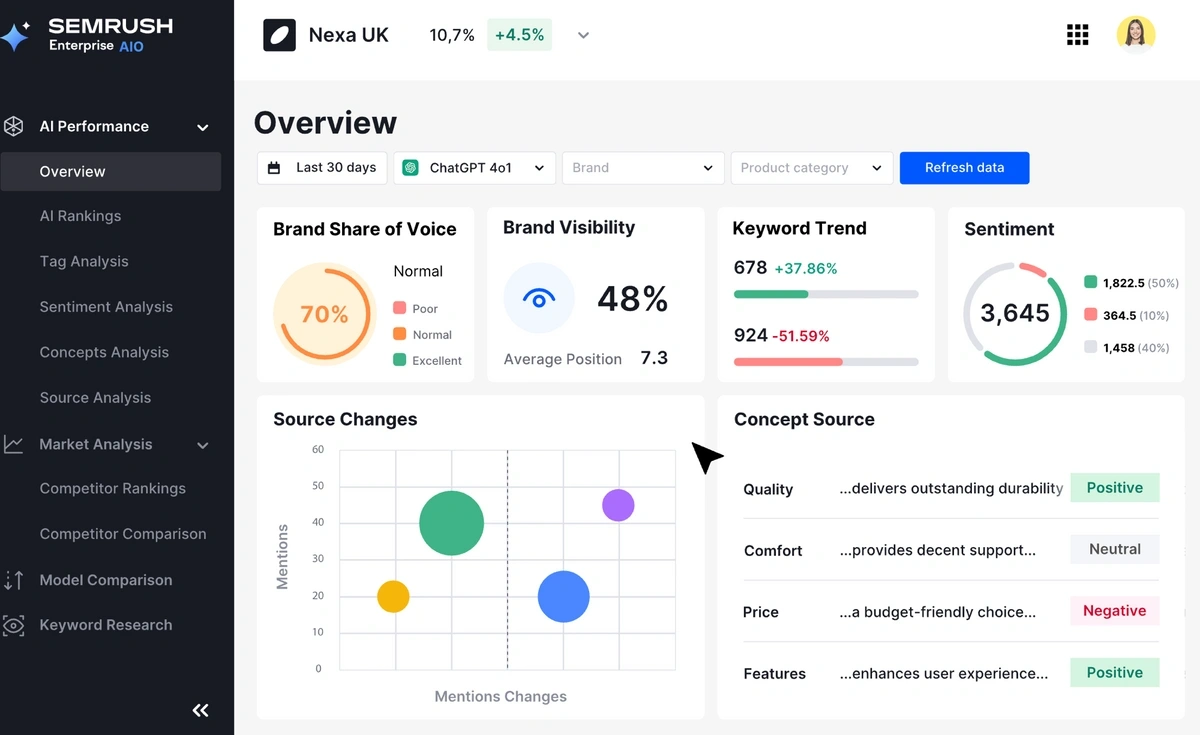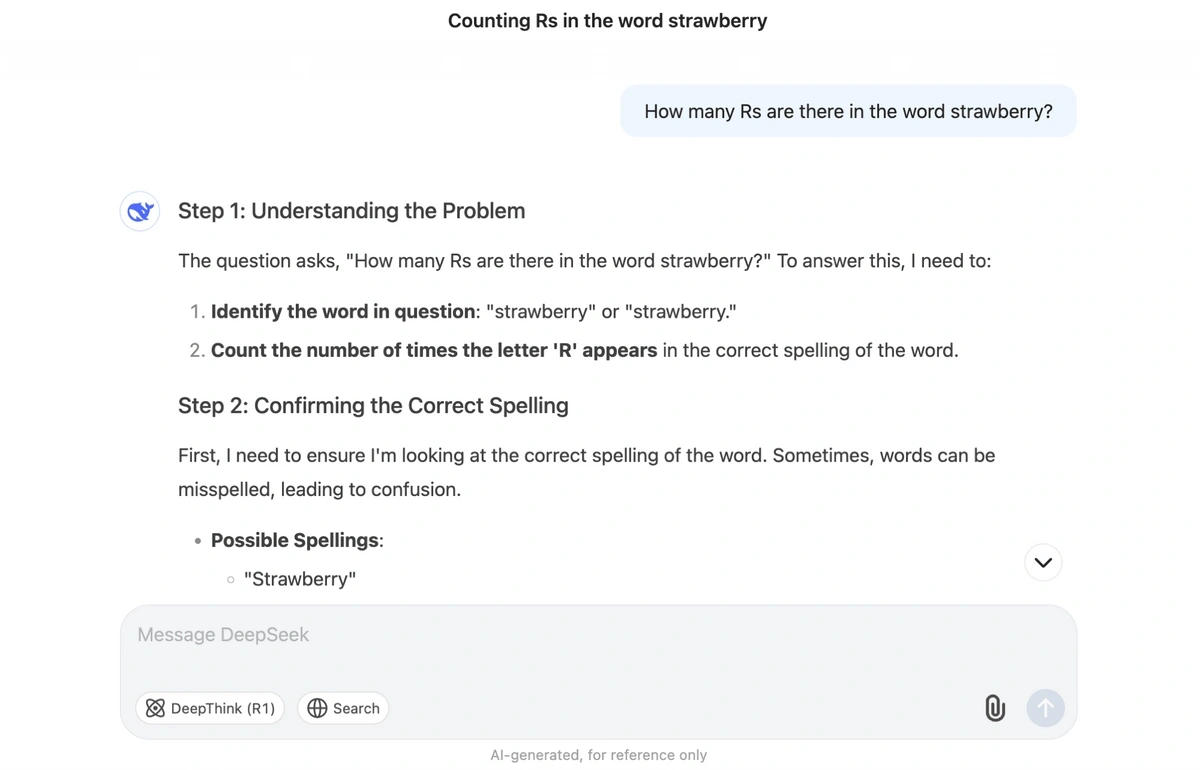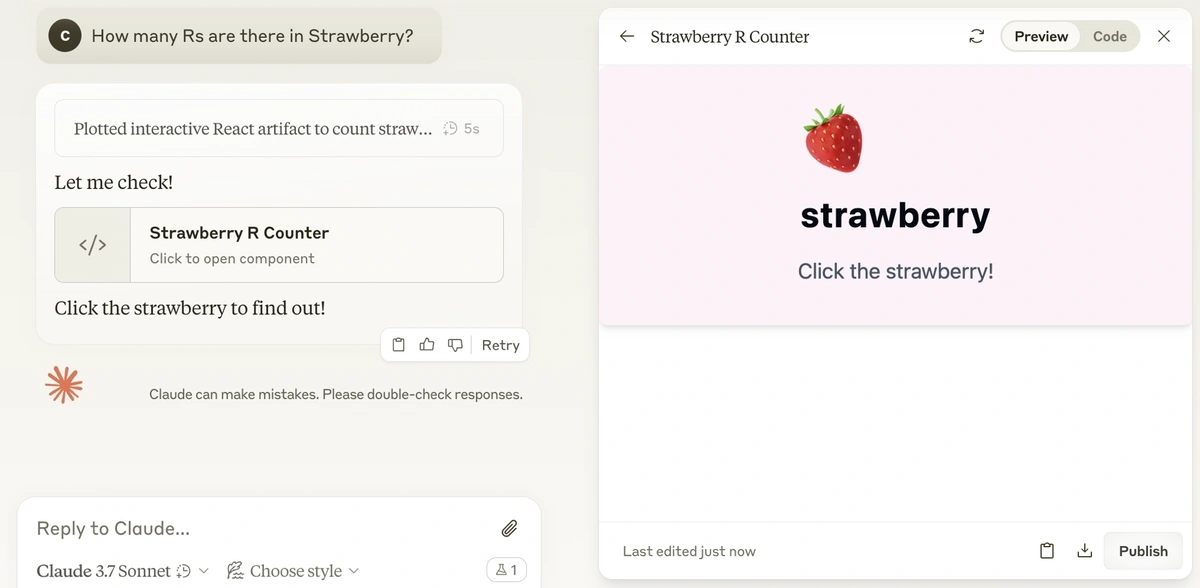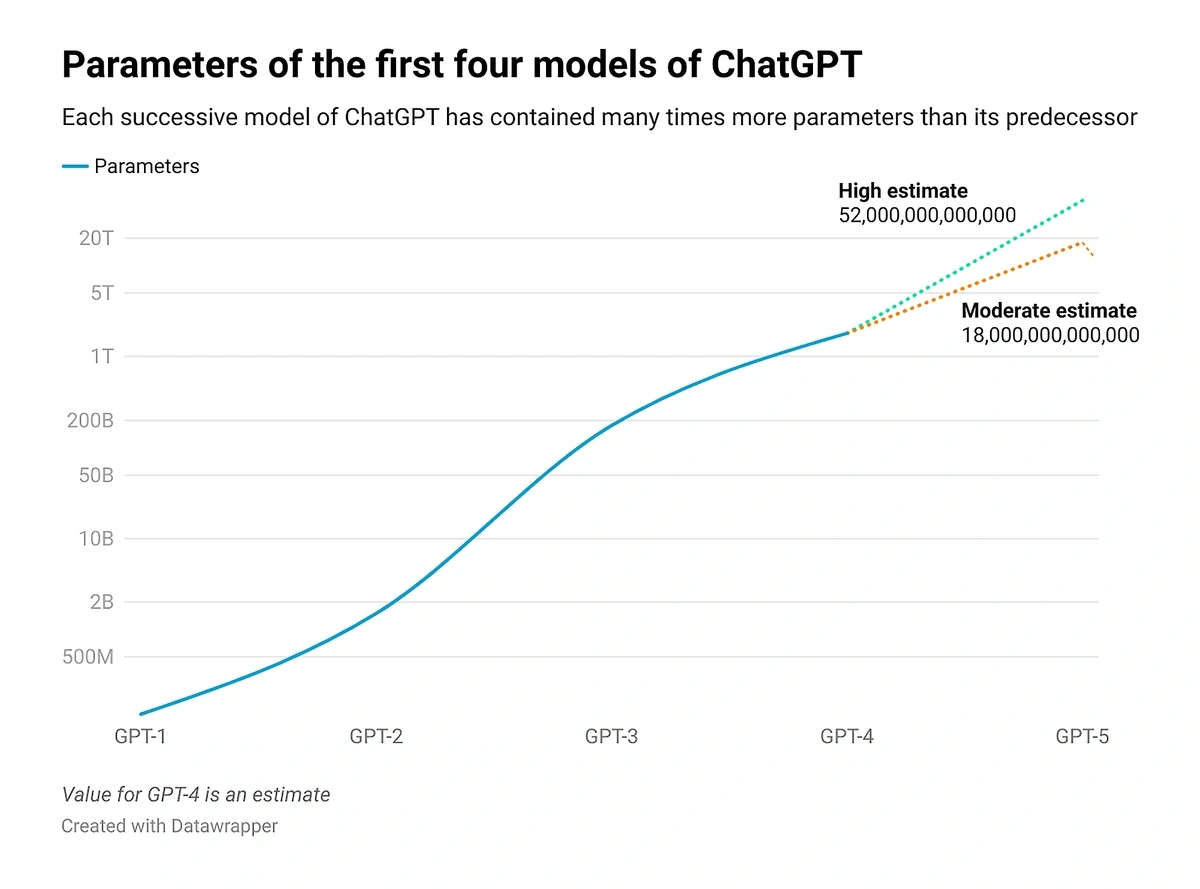
When Will ChatGPT-6 Be Released? (August 2025)
OpenAI has officially released GPT-5, marking a significant leap forward in artificial intelligence.
But AI analysts are already talking about what GPT-6 might look like.
The release of GPT-5 did not go entirely to plan, leading some AI experts to talk about the risk of an AI bubble.
When Will ChatGPT-6 Be Released?
Sam Altman is quoted as saying that the wait for GPT-6 will be shorter than the wait for GPT-5.
GPT-4 and GPT-5 were released 28 months apart: GPT-4 was released on March 14, 2023. GPT-5 was released on August 7, 2025.
So we should see GPT-6 released before December 2027.
The latest news on ChatGPT-6 is from August 19, 2025. Altman said that GPT-6 will be "different":
GPT-6 will adapt to user preferences for more personalization.
Speaking to reporters, Altman said he thinks GPT-6 should be able to adapt to your own preferences.
Altman wants memory to be a core feature of GPT-6.
He indicated that memory will be a core feature to help ChatGPT users feel understood.
He said OpenAI is working with psychologists to understand how ChatGPT makes them feel.
This may include tracking their wellbeing, which is an important consideration due to the increase in news stories about AI psychosis.
Altman said ChatGPT-6 will comply with the US government's requirements for ideologically neutral AI.
President Donald Trump issued an Executive Order in July 2025 that stated AI should not "sacrifice truthfulness and accuracy to ideological agendas".
Sam Altman said GPT-6 should be customizable from a neutral stance, adding, “If you’re like, ‘I want you to be super woke’ — it should be super woke.”
He said the GPT-6 rollout will be smoother than the GPT-5 release.
OpenAI restored GPT-4o for paying users after admitting that there were issues with the GPT-5 release.
What Else Is OpenAI Planning?
Looking ahead, OpenAI’s internal roadmap, partially revealed in this heavily redacted leaked memo, suggests the next evolution of ChatGPT will be far more than an incremental update.
Instead, the company is preparing to unveil what it refers to internally as a “super-assistant,” powered by the upcoming o3‑pro model, which brings deeper reasoning, autonomy, and software-level control.
Increased Shopping Focus
In late September 2025, ChatGPT added an Instant Checkout feature that allows ChatGPT users to make purchases without leaving their chat.
The new feature is powered by Stripe's open source Agentic Commerce Protocol.
This is not entirely new. Before this feature was added, ChatGPT already had e-commerce functionality, including aggregated reviews and sentiment analysis.
Bringing the purchase flow inside ChatGPT is a clear sign that OpenAI sees e-commerce as an important priority.
From Chatbot to Entity
According to the memo, OpenAI plans to position ChatGPT as a T‑shaped user entity broadly capable of everyday tasks.
These would include managing calendars, booking travel, sending emails, while also offering deep expertise in complex domains such as programming or strategic research.
This combination would allow ChatGPT to act as a trustworthy and emotionally intelligent personal assistant rather than a simple chatbot.
Tools That Take Action
Crucially, the new assistant is described as having agentic abilities.
Features such as “Computer Use” are designed so ChatGPT can interact with applications and interfaces on behalf of the user, taking real-world actions rather than simply offering advice.
Search That Lives Inside It
OpenAI is also reportedly building a proprietary search index, allowing the assistant to navigate the web and take action without relying on traditional search engines .
This move would reinforce ChatGPT’s role as an active interface, not just a passive chatbot.
In August 2025, researchers revealed that OpenAI is heavily reliant on Google's search index and has been using SerpAPI scraping to obtain results.
OpenAI’s Nick Turley indicated that this may be temporary. “Our goal—which was a lofty goal, and we’re nowhere near close—is to serve about 80% of our traffic from our own first-party index,”
Timing & Preview Signals
The memo indicates that the transition to this super assistant mode was targeted for the first half of 2025.
With a limited preview of o3‑pro already underway among select users, OpenAI is expected to announce the full public rollout very soon.
What Happened With the Release of GPT-5?
Building on the strengths of its predecessors, GPT-5 introduces a range of improvements in reasoning, contextual understanding, and multimodal capabilities. The latest version is designed to be more accurate, more adaptable, and significantly more aligned with human intent.
In this article, we’ll explore just how much more powerful GPT-5 is compared to previous versions.
The Race Heats Up: OpenAI Faces Fierce Competition as Rivals Gain Ground
While ChatGPT was revolutionary on its launch a few years ago, it’s now just one of several powerful AI tools.
With competitors pouring billions of dollars into AI research, development, and marketing, OpenAI needs to ensure it remains competitive in the AI arms race.
As we waited for GPT-5, companies developing competing LLMs had time to catch up.
Google is pushing ahead with the launch of AI Mode, which uses a chatbot-like experience in Google search.
After rolling out in the US, AI Mode is now available for English-language queries in India from June 24th, 2025, and the UK from July 28th.
Google has also increased the number of AI Overviews showing on organic search results pages. Now, more than 13% of regular Google searchers trigger an AIO.
This has left businesses looking for data on AI search habits. Tools like Semrush Enterprise AIO provide brand-new tracking tools for several AI search platforms, including ChatGPT.
Released in January 2025, DeepSeek R1 is a Chinese model that replicates the reasoning capability and performance of OpenAI's o1. Importantly, DeepSeek is open source and free.
DeepSeek costs a fraction of the amount to train. This shook the stock market and introduced some new doubts over OpenAI's potential to be profitable.
On February 24th, 2025, Anthropic released Claude 3.7, its first hybrid reasoning model. Anthropic said that Claude 3.7 has been developed for real-world business usage rather than specialized tasks, like complex math problems. It has since released Claude 4.
ChatGPT-4 was released just three months after GPT-3.5, so users were accustomed to seeing regular model releases from OpenAI.
Time Since Previous ChatGPT Release
| Model | Release Date | Months Since Previous Release |
| GPT-2 | February 14, 2019 | |
| GPT-3 | June 11, 2020 | 15 |
| GPT-3.5 | November 30, 2022 | 29 |
| GPT-4 | March 14, 2023 | 3 |
| GPT-4o | May 13, 2024 | 13 |
| GPT-o1 | September 12, 2024 | 3 |
| GPT-o3 | January 31, 2025 | 4 |
| GPT-4.5 | February 27, 2025 | 2 |
| GPT-4.1 | April 14, 2025 | <1 |
| GPT-o3 | April 16, 2025 | <1 |
| GPT-o4-mini | April 16, 2025 | <1 |
| GPT-5 | August 7, 2025 | 4 |
OpenAI's releases have been faster in the past 12 months. But seems there were delays in bringing GPT-5 to market.
In March 2024, Sam Altman was interviewed on the Lex Fridman Podcast. He told Lex that OpenAI plans to release an “amazing new model this year.”
Additionally, Business Insider published a report about the release of GPT-5 around the same time as Altman’s interview with Lex Fridman. Sources told Business Insider that GPT-5 would be released during the summer of 2024.
Altman could have been referring to GPT-4o, which was released a couple of months later. However, it’s also possible that he meant GPT-5.
OpenAI faced the same challenge that other LLM providers face: a lack of training data. The solution is to use synthetic data: information created for the specific purpose of training LLMs.
Why GPT-5 Is Later Than Expected
Safety testing was likely the largest hurdle facing GPT-5’s release.
ChatGPT (and AI tools in general) have generated significant controversy for their potential implications for customer privacy and corporate safety.
OpenAI has already incorporated several features to improve the safety of ChatGPT. For example, independent cybersecurity analysts conduct ongoing security audits of the tool. They attempt to find vulnerabilities, which are then patched.
OpenAI also runs a “bug bounty” program, which rewards people for finding and reporting security flaws in ChatGPT.
However, many still have safety concerns about AI.
In March 2023, for example, Italy banned ChatGPT, citing how the tool collected personal data and did not verify user age during registration. The following month, Italy recognized that OpenAI had resolved the problems and allowed it to resume ChatGPT service in the country.
In May 2023, Sam Altman testified before the Senate Judiciary Committee in favor of government regulation to “mitigate the risks” of AI tools. Altman recognized the widespread fears about the potential dangers of AI, including misuse, and argued in favor of an agency with the power to license AI tools — and “take that license away” to “ensure compliance with safety standards.”
More generally, hallucinations remain a significant barrier. The BBC reported that AI chatbots are unable to produce accurate summaries of news articles, leading to concerns about misinformation online.
In July 2025, Sam Altman was quoted saying he had concerns about the extent of ChatGPT use among young people, particularly for therapy.
Altman said, "Right now, if you talk to a therapist or a lawyer or a doctor about those problems, there’s legal privilege for it. There’s doctor-patient confidentiality, there’s legal confidentiality, whatever. And we haven’t figured that out yet for when you talk to ChatGPT."
It would be catastrophic for OpenAI to press for stringent safety standards and then fall short itself.
What Can GPT-5 Actually Do?
In the lead-up to GPT-5’s launch, Sam Altman and OpenAI remained characteristically tight-lipped about specific capabilities. Still, cryptic hints on X and public comments gave a sense that something significant was coming.
“It’s not like this model is going to get a little bit better,” Altman said at the World Governments Summit in Dubai back in February 2024. “It’s going to be better across the board.”
Now that GPT-5 is here, we know what that means in practice.
What is the Capability of GPT-5?
The new model integrates a suite of advanced tools: voice interaction, real-time web search, canvas for spatial reasoning, and a new feature called Deep Research, designed to help users go far beyond surface-level answers.
As of launch, Deep Research is available across several tiers. ChatGPT Plus, Team, Education, and Enterprise users get 10 Deep Research queries per month, while Pro users get 120. These allow users to generate structured, source-backed research summaries, making ChatGPT feel less like a chatbot and more like an expert research assistant.
Smarter, Simpler, and More Seamless
At its core, GPT-5 represents a meaningful leap in intelligence over its predecessors. While “smarter” is a broad term, in practical use, it translates into sharper contextual understanding, more accurate and relevant responses, and a significant reduction in hallucinations.
Under the hood, GPT-5 introduces architectural improvements that make it faster and more efficient at processing information. This isn’t just about better answers, it’s about a model that can reason more deeply, adapt more intuitively, and operate more effectively across a wider range of tasks.
Importantly, GPT-5 introduces tiered intelligence: free-tier users get access to a more basic level of the model, while paid subscribers benefit from higher-capability modes that deliver enhanced performance.
GPT-5 replaces the model switcher.
In response to user feedback and internal reflection, OpenAI is simplifying the ChatGPT experience. The often-confusing model switcher is going away. Instead of juggling between GPT-4o, o1, and others, users will interact with a unified GPT-5 experience that intelligently adapts based on context and task complexity.
As Altman put it, GPT-5 “will know when to think for a long time or not", offering a smoother, smarter interaction without forcing users to choose which model to use. This move reflects OpenAI’s broader effort to streamline its product line by resetting naming conventions, consolidating features, and delivering a model that feels more like a cohesive assistant than a menu of options.
Build a winning strategy
Get a complete view of your competitors to anticipate trends and lead your market
A Smarter Model, Trained on More and Built for More
One of the key ways GPT-5 becomes "smarter" is through its expanded training process. OpenAI has trained the new model on an even larger and more diverse dataset than ever before, pulling not only from publicly available internet data, but also from a growing pool of proprietary sources.
These proprietary datasets allow GPT-5 to learn from specialized domains often missing from the public web. That includes niche topics, underrepresented languages, extended multi-turn conversations, and complex real-world scenarios. The result is a model that’s not just broadly informed, but also more capable in depth and detail.
This richer training foundation should translate into better performance in areas where earlier models fell short, especially with technical or domain-specific questions, non-English languages, and longer-form reasoning.
GPT-5 is also more customizable than previous versions.
OpenAI has emphasized that individuals and enterprises will have more control over how the model behaves, tailoring it to specific workflows, tone preferences, or industry needs. This opens the door to more flexible, task-oriented use cases, from business operations to education and content creation.
And crucially, GPT-5 continues to evolve as a truly multimodal AI. While GPT-4 introduced limited multimodal capabilities that could process both text and images, GPT-5 takes this further. According to Altman, GPT-5 can now seamlessly handle speech, vision, reasoning, and research without the need to switch between models or interfaces. Whether you're asking a question, uploading a diagram, or having a spoken conversation, GPT-5 is built to respond in kind.
Altman said at the World Governments Summit: “All of this is a bigger deal than it sounds. What makes these models so magical is that they’re general. If it’s a little bit smarter, it’s a little better at everything”.
Is ChatGPT-5 Sentient?
GPT-5 is undeniably more advanced than both GPT-4 and GPT-4o. And if Sam Altman’s vision holds true, this isn’t just a marginal upgrade, it’s a system that’s “better across the board.”
But that raises a deeper, more philosophical question: is this simply another step in AI progress, or are we inching closer to artificial general intelligence (AGI)?
AGI refers to a machine capable of reasoning, learning, and adapting with the flexibility and depth of human intelligence. It wouldn’t just follow instructions, it would understand them, operate autonomously, and apply its intelligence to unfamiliar tasks.
One of the most well-known thought experiments for evaluating AGI is The Coffee Test, proposed by Apple co-founder Steve Wozniak. Imagine a robot walking into your kitchen, finding the coffee maker, identifying the right ingredients, and brewing a cup – all without being explicitly programmed to do so. That level of independent problem-solving is considered a hallmark of general intelligence.
While GPT-5 doesn’t pass the Coffee Test, it’s getting closer to something more humanlike in its ability to reason, adapt, and interact. And with each new release, the AGI question becomes less theoretical and more immediate.
The implications are massive. In March 2023, thousands of researchers and tech leaders – including Elon Musk – signed an open letter urging a pause on the development of AI systems more powerful than GPT-4. Just months later, OpenAI publicly stated it had halted training on a GPT-4 successor, a decision that became a flashpoint in the dramatic internal conflict between Sam Altman and the OpenAI board later that year.
That standoff ultimately ended with Altman regaining control of the company, along with a renewed mandate to keep pushing forward.
So, is GPT-5 the beginning of AGI? Not quite. But it’s a meaningful step in that direction. And as Altman has repeatedly hinted, OpenAI is building with that long-term goal very much in mind.
How is ChatGPT-5 Different From Previous Models?
Nevertheless, GPT-5 is certainly a great deal more capable than GPT-4. No one has been clearer about this than Sam Altman.
In March 2024, Altman told Lex Fridman that GPT-4 “kind of sucks.” He said that “the delta between 5 and 4 will be the same as between 4 and 3… It is our job to live a few years in the future and remember that the tools we have now are going to kind of suck looking backward at them.”
The Main Differences Between GPT-5 and GPT-4
There are many differences in the way GPT-5 and GPT-4 work:
- Instead of switching between different GPT or o-series models, users now interact with a single, consolidated model. GPT-5 takes on the responsibility of determining how to process each prompt so users no longer need to toggle between options manually. OpenAI touted this as a way to improve the user experience. Critics believe that it may have been a cost-cutting measure that routed all queries through the cheaper model first.
- GPT-5 is designed to better recognize and deliver its most accurate, high-quality responses. This claim has been contested, not least on Reddit, with high-profile viral threads of GPT-5 getting things wrong.
- The tone of GPT-5 has changed, which sparked an outcry on social media. Users preferred the 'friendlier' and more human-like tone of GPT-4.
OpenAI claims it gave the model not just more data, but higher-quality and more representative information.In large part, that’s because GPT-5 is being trained on a much larger dataset than GPT-4.
| Model | Training Time (Years) | Retail Cost |
| GPT-3 | 405 | $9,000,000 |
| GPT-4 | 6,507 | $224,000,000 |
| Gemini | 15,616 | $440,000,000 |
| GPT-5 | 16,438 | $612,000,000 |
| Grok 3 | 32,855 | $1,200,000,000 |
Source: LifeArchitect
GPT-4 Was Much Smarter Than GPT-3
As Altman noted, GPT-4 was already a significant improvement over GPT-3.
For starters, GPT-3 is unimodal. It can only process text inputs. Additionally, it was trained on a much lower volume of data than GPT-4. That means lesser reasoning abilities, more difficulties with complex topics, and other similar disadvantages.
GPT-3 also has far fewer parameters than GPT-4. Parameters essentially determine how an AI model behaves. The number and quality of the parameters guiding an AI tool’s behavior are therefore vital in determining how capable that AI tool will perform.
In general, more parameters mean a more powerful AI. GPT-3 had roughly 175 billion parameters. While the number of parameters in GPT-4 has not officially been released, estimates have ranged from 1.5 to 1.8 trillion.
Key Takeaways
GPT-5 marks a turning point not just in performance, but in how users experience and interact with AI.
As OpenAI moves toward building a proactive, all-in-one assistant, GPT-5 lays the foundation for an AI that doesn’t just answer questions, but actively helps shape the way we work, learn, and live.
Stop Guessing, Start Growing 🚀
Use real-time topic data to create content that resonates and brings results.
Exploding Topics is owned by Semrush. Our mission is to provide accurate data and expert insights on emerging trends. Unless otherwise noted, this page’s content was written by either an employee or a paid contractor of Semrush Inc.
Share
Newsletter Signup
By clicking “Subscribe” you agree to Semrush Privacy Policy and consent to Semrush using your contact data for newsletter purposes
Written By


Josh is the Co-Founder and CTO of Exploding Topics. Josh has led Exploding Topics product development from the first line of co... Read more






